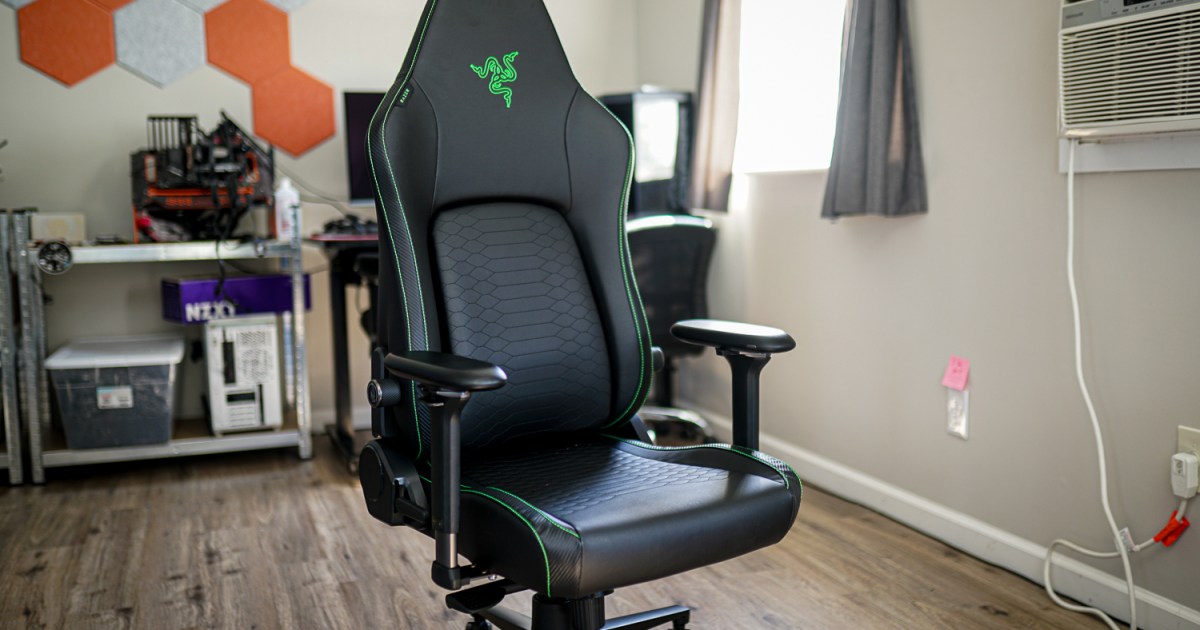Razer’s most boring product is also one of its best
The Razer Iskur V2 doesn't have any gimmicks, and that's exactly what makes it one of the exciting products from the company.

 Jacob Roach / Digital Trends
Jacob Roach / Digital TrendsRazer isn’t exactly known for subtlety. This is the company that released a Bane-like RGB face mask, a headset with haptic feedback, and most recently, a mouse pad that has RGB lighting from corner to corner. The Iskur V2 chair is an exercise in subtlety, however, and a change of pace that pays off for Razer in a big way.
There’s nothing special about the Iskur V2 at first glance. It’s a gaming chair fit with the usual racer-style back and some green trim to let you know it’s a Razer product. But there are no motors promising immersive haptic feedback, and no RGB leaving you tethered to a wall outlet (yes, Razer has done both in a chair before). The Iskur V2 is just a well-designed, comfortable chair, and that’s exactly why it’s so impressive.
Out of the box
 Jacob Roach / Digital Trends
Jacob Roach / Digital TrendsIt’s always a bit of a hassle setting up a gaming chair, but Razer adds a couple of conveniences to smooth out the process with the Iskur V2. In the box, the chair is split up into the base, back, arm rests, stand, and wheels, with a few extras like covers for the base and sides. Even with my kitchen in a mess of plastic and foam, putting together the Iskur V2 took me less than 30 minutes.
 Jacob Roach / Digital Trends
Jacob Roach / Digital TrendsBefore pulling everything out, you’ll find a massive card that stretches the width of the box with instructions. Throw it on the ground and get to building, rather than constantly fishing around for your spot in the instruction booklet. Given how cleanly everything is laid out in the box, and the large instructions, it was easy to identify what I needed and put the chair together without fussing around with all of the components.
 Jacob Roach / Digital Trends
Jacob Roach / Digital TrendsThe process is fairly straightforward, screwing in some bolts with locking nuts to attach everything together, but Razer goes above and beyond in two ways. First, the included Allen wrench has a grip. It’s a small thing, but if you’ve put together a few of these chairs, you already know how much of a pain it is to crank the bolts in with a tiny hex key.
Everything went in easily here, too, which more than I can say for my previous Secretlab Omega chair.
 Jacob Roach / Digital Trends
Jacob Roach / Digital TrendsThe second convenience is a slot for the back of the chair. Normally, you have to support the back of the chair while you screw in the bolts that connect it to the base. With the Iskur V2, Razer includes a slot where you can line up the back of the chair, allowing it to support itself while you screw everything together. Razer still recommends two people put together the chair, to be clear, but with this support slot, I was able to do it by myself.
I was dreading the day the Iskur V2 showed up on my doorstep, expecting to set aside an afternoon to thumb through the instructions and cramp my hand trying to put everything together. Instead, I was able to get the chair set up in around a half hour, and that’s due to a few thoughtful choices on Razer’s part.
Endless adaptability
 Jacob Roach / Digital Trends
Jacob Roach / Digital TrendsThe Iskur V2 may be easy to set up, but it really stands out with its adjustability. The big claim to fame is the adjustable lumbar support that’s built into the chair. Similar to the Secretlab Titan Evo, you have two dials on the sides of the chair that adjust the support’s depth and height. The support also pivots back and forth, moving with your back to provide constant support.
It’s a massive upgrade for comfort if you’re coming from a cheaper gaming chair like the . The memory foam supports you find on more inexpensive options aren’t much of a support at all, and the Iskur V2’s backing has transformed how I sit in my chair.
 Jacob Roach / Digital Trends
Jacob Roach / Digital TrendsOutside of the lumbar support, Razer also makes a big deal about its “4D armrests,” presumably because Razer conjured a fourth dimension for them. Branding nonsense aside, the armrests have four adjustment points — up and down, left and right, forward and back, and in and out. That’s not unique, but Razer uses thick metal locks for each of the adjustment points, making them feel more premium and more secure.
What stands out more is the base of the chair. You normally see aggressive slants on the edges of gaming chairs, but the Iskur V2 is surprisingly flat. There’s only a slight curve on the edge, giving you a nice platform to sit on if you have a larger frame. Razer carries this openness up the back of the chair as well, so you don’t feel crammed in at the shoulders.
 Jacob Roach / Digital Trends
Jacob Roach / Digital TrendsThe base and adjustable lumbar support stand out most, but Razer has the usual trimmings you expect of a gaming chair here, as well. There’s an included memory foam pillow that wraps around the top of the chair — and it’s surprisingly comfortable — and you can lay the chair almost completely flat through a combination of reclining and leaning the chair back.
The right chair (for a price)
 Jacob Roach / Digital Trends
Jacob Roach / Digital TrendsThe only thing holding me back from a glowing recommendation of the Iskur V2 is the price. At $650, it’s quite a bit more expensive than Secretlab Titan Evo, which you can pick up directly from Secretlab for $550. Even if you account for the XL version of the Titan Evo, which has a weight and height range more aligned with the Iskur V2, Razer still comes out $50 more expensive.
Maybe not a glowing recommendation because of price, but the Iskur V2 gets a recommendation nonetheless. It’s an extremely comfortable chair with the right mix of ergonomics and flair, and without resorting to the gimmicks Razer has in the past. You can find much cheaper gaming chairs like the aforementioned Corsair TC100 or , but Razer makes the money you spend on the Iskur V2 feel worth it.

 Konoly
Konoly 



























.jpg&h=630&w=1200&q=100&v=154b70b92d&c=1)





